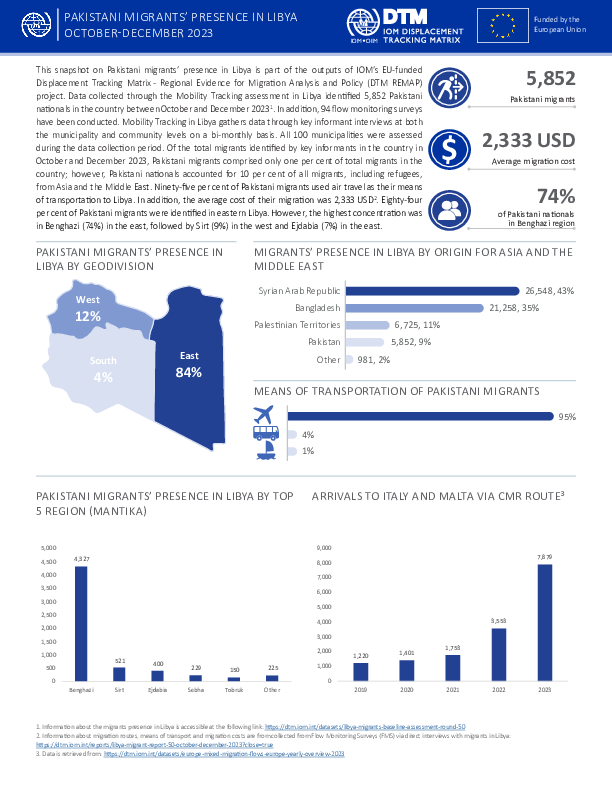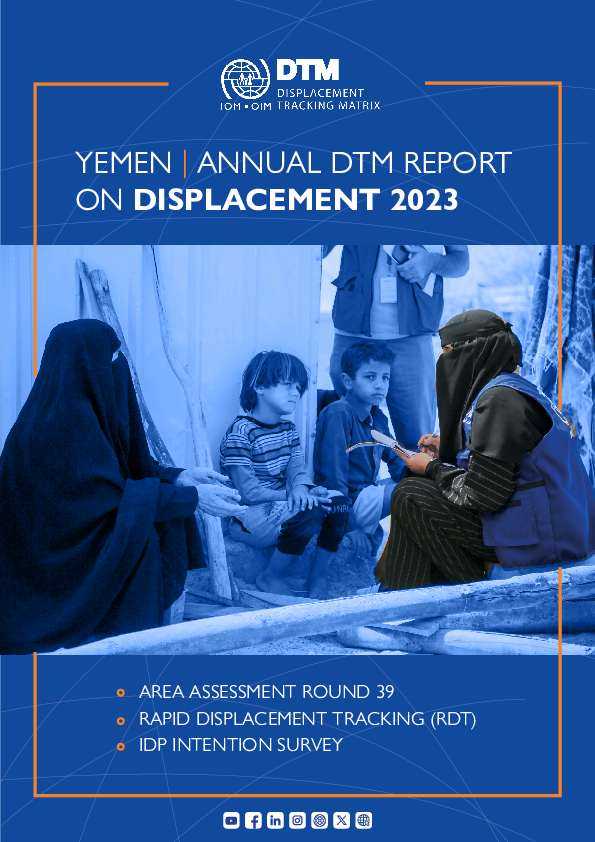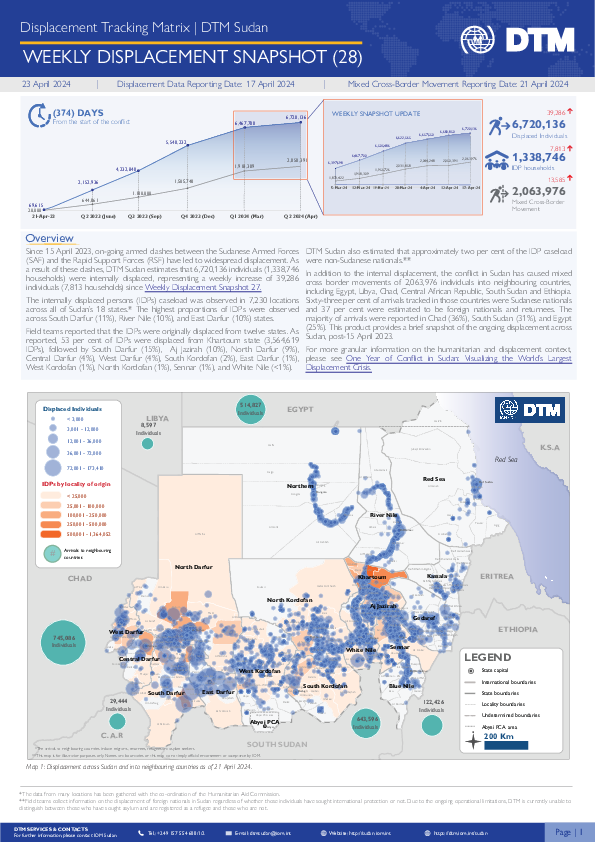-
Countries
-
Data and Analysis
-
Special Focus
-
Crisis Responses
Baseline Assessment

Contact
DTM Libya, DTMLibya@iom.int
Language
English
Location
Libya
Period Covered
Jan 01 2024
Feb 29 2024
Activity
- Mobility Tracking
- Baseline Assessment
The number of migrants in Libya has been increasing since September 2023 and stands at its highest since DTM started operating in Libya. Previously, the number of migrants in Libya had declined as a result of the COVID-19 pandemic and its socioeconomic impact. Some factors that may explain the increase in the number of migrants includes a rise in the number of Sudanese nationals, particularly in Alkufra and other locations in eastern Libya because of the ongoing conflict in their country of origin. In parallel, DTM Libya also observed an increase in the number of nationals, particularly from Egypt and Sudan, in some municipalities in the east and southwest as a result of greater livelihood opportunities, including in the construction and agricultural sectors.
Contact
dtmlibya@iom.int
Location
Libya
Activity
- Mobility Tracking
- Baseline Assessment
Period Covered
Jan 01 2024 -Feb 29 2024
Libya Migrants baseline assessment Round 51
Population Groups
Migrants Present
Survey Methodology
Unit of Analysis Or Observation
Admin Area 2
Admin Area 3
Admin Area 4
Type of Survey or Assessment
Key Informant
Keywords
Geographical Scope Full Coverage
Administrative boundaries with available data
The current dataset covers the following administrative boundaries

Contact
DTM Pakistan, iomisbdtmremapteam@iom.int; DTM Libya, DTMLibya@iom.int
Language
English
Location
Libya
Period Covered
Oct 01 2023
Dec 31 2023
Activity
- Survey
- Flow Monitoring Survey
- Mobility Tracking
- Baseline Assessment
This snapshot on Pakistani migrants’ presence in Libya is part of the outputs of IOM’s EU-funded Displacement Tracking Matrix - Regional Evidence for Migration Analysis and Policy (DTM REMAP) project. Data collected through the Mobility Tracking assessment in Libya identified 5,852 Pakistani nationals in the country between October and December 20231. In addition, 94 flow monitoring surveys have been conducted. Mobility Tracking in Libya gathers data through key informant interviews at both the municipality and community levels on a bi-monthly basis. All 100 municipalities were assessed during the data collection period. Of the total migrants identified by key informants in the country in October and December 2023, Pakistani migrants comprised only one per cent of total migrants in the country; however, Pakistani nationals accounted for 10 per cent of all migrants, including refugees, from Asia and the Middle East. Ninety-five per cent of Pakistani migrants used air travel as their means of transportation to Libya. In addition, the average cost of their migration was 2,333 USD2. Eighty-four per cent of Pakistani migrants were identified in eastern Libya. However, the highest concentration was in Benghazi (74%) in the east, followed by Sirt (9%) in the west and Ejdabia (7%) in the east.
Contact
DTM Sudan, DTMSudan@iom.int
Location
Sudan
Activity
- Mobility Tracking
- Baseline Assessment
Period Covered
Apr 12 2024 -Apr 17 2024
- DTM Sudan estimates that 6,720,136 individuals (1,338,746 households) were displaced internally since 15 April 2023.
- The IDP caseload was observed in 7,230 locations across all of Sudan’s 18 states.
- The highest proportions of IDPs were hosted across South Darfur (11%), River Nile (10%), and East Darfur (10%).
- Field teams reported that the IDPs observed were originally displaced from twelve states. The majority (3,564,619 IDPs, 53%) were reportedly displaced from Khartoum state; followed by South Darfur (15%), Aj Jazirah (10%), North Darfur (9%), Central Darfur (4%), West Darfur (4%), South Kordofan (2%), East Darfur (1%), West Kordofan (1%), North Kordofan (1%), Sennar (1%) and White Nile (<1%).
- IOM-DTM also reported that an estimated 2,063,976 mixed cross-border movements were made into neighbouring countries.
A more detailed version of this dataset is available, to get access kindly click on the 'Request Access' button
Population Groups
IDPs
Survey Methodology
Unit of Analysis Or Observation
Site or Location
Type of Survey or Assessment
Key Informant
Keywords
Geographical Scope Partial Coverage
Administrative boundaries with available data
The current dataset covers the following administrative boundaries

Contact
DTM Yemen, IOMYemenDTM@iom.int
Language
English
Location
Yemen
Period Covered
Jan 01 2023
Dec 31 2023
Activity
- Survey
- Mobility Tracking
- Event Tracking
- Baseline Assessment
Please note that this report is divided into three sections:
- Area Assessment (AA)
- Rapid Displacement Tracking (RDT)
- The IDP Intention Survey (IS)
The report contains cross-cutting descriptive analyses from a combination of data sources to provide the best possible overview.
The Area Assessment remains the most suitable source of information on target population sizes and locations. Rapid Displacement Tracking (RDT) should be understood as indicative of new displacement events and trends without serving as a source of population sizes as households may experience multiple displacements during the reporting period or might have returned before the end of the reporting period. Both the Area Assessment and RDT are based on key informant interviews. The intention survey (here based on 13,307 face-to-face interviews in May 2023) serves to provide insights into past and present motives of displaced populations, thereby providing a more personal profile of affected populations.
Contact
DTM Sudan, DTMSudan@iom.int
Location
Sudan
Activity
- Mobility Tracking
- Baseline Assessment
Period Covered
Apr 05 2024 -Apr 12 2024
- DTM Sudan estimates that 6,680,850 individuals (1,330,933 households) were recently internally displaced.
- The IDP caseload was observed in 7,143 locations across all of Sudan’s 18 states.
- The highest proportions of IDPs were observed across South Darfur (11%), River Nile (11%), and East Darfur (10%).
- Field teams reported that the IDPs observed were originally displaced from twelve states. The majority (3,560,858 IDPs, 54%) were reportedly displaced from Khartoum state; followed by South Darfur (15%), Aj Jazirah (10%), North Darfur (9%), Central Darfur (4%), West Darfur (4%), South Kordofan (2%), East Darfur (1%), West Kordofan (1%), North Kordofan (1%), Sennar (1%) and White Nile (<1%).
- IOM-DTM also reported that an estimated 2,050,391 mixed cross-border movements were made into neighbouring countries.
A more detailed version of this dataset is available, to get access kindly click on the 'Request Access' button
Population Groups
IDPs
Survey Methodology
Unit of Analysis Or Observation
Site or Location
Type of Survey or Assessment
Key Informant
Keywords
Geographical Scope Partial Coverage
Administrative boundaries with available data
The current dataset covers the following administrative boundaries
Contact
DTMMali@iom.int
Location
Mali
Activity
- Mobility Tracking
- Baseline Assessment
Period Covered
Oct 01 2023 -Dec 31 2023
During the data collection and update operation conducted in December 2023, a total of 354,739 IDPs were identified. The number of IDPs indeed decreased from 391,961 individuals in September 2023 (September 2023 DTM report) to 354,739 in December 2023. Therefore, from September 2023 to December 2023, a decrease of 37,222 displaced persons (approximately 9% decrease) was observed.
Population Groups
IDPs
Returnee (Previously Internally Displaced)
Survey Methodology
Unit of Analysis Or Observation
Admin Area 3
Individual
Type of Survey or Assessment
Key Informant
Keywords
Geographical Scope Full Coverage
Administrative boundaries with available data
The current dataset covers the following administrative boundaries

Contact
DTM Tchad, dtmtchad@iom.int
Language
French
Location
Chad
Period Covered
Jan 03 2024
Feb 08 2024
Activity
- Mobility Tracking
- Baseline Assessment
- Site Assessment
Suite au conflit armé survenu en avril 2023 au Soudan, des milliers de personnes ont été contraints de quitter ce pays pour se réfugier au Tchad, principalement à l’Est. Ces ressortissants tchadiens vivant au Soudan depuis des nombreuses années ont été enregistrés par l’OIM dans 41 lieux de déplacement dans les provinces du Sila et du Ouaddaï. La majorité (61 %) des sites de déplacement se trouvent dans la sous-préfecture d'Adre et constituent 55 pour cent de la population totale des retournés dans les deux provinces.
En effet, l’objectif de cette évaluation était de mesurer les profils, les vulnérabilités, les infrastructures ainsi que les besoins des populations déplacées à la suite de cette crise, afin de mieux orienter les résultats vers la planification de solutions durables pour les personnes déplacées. Les données sont collectées à travers des entretiens avec des informateurs clés (autorités locales, chefs traditionnels, représentants des personnes déplacées et gestionnaires de sites) dans les villages et sites d’accueil des personnes déplacées, ainsi que par des observations directes dans ces localités.
Ainsi, ce tableau de bord présente les résultats d'évaluations menées du 03 janvier au 08 février 2024, dans 41 lieux de déplacement situés dans les provinces du Ouaddaï et Sila.
Contact
DTM Sudan, DTMSudan@iom.int
Location
Sudan
Activity
- Mobility Tracking
- Baseline Assessment
Period Covered
Mar 29 2024 -Apr 04 2024
- An estimated 6,657,550 individuals were displaced internally within Sudan since the start of the conflict one year ago, on 15 April 2023.
- Approximately 2,044,248 individuals were reportedly displaced across borders into neighbouring countries.
- An estimated 13 per cent of the population in Sudan was displaced during the past year of conflict.
- Over half (approximately 53%) of individuals internally displaced were children, under the age of 18 years old. Approximately 22 per cent were children under the age of 5 years old.
- Approximately 10 per cent of localities across Sudan experienced a population increase of 50 per cent or higher due to the influx of displaced individuals, exacerbating pressure on already-limited resources and services.
- Sudan hosted approximately 13 per cent of all internally displaced persons globally, and nearly 1 in every 8 internally displaced persons worldwide is Sudanese.
- Approximately 28 per cent of displaced individuals were female children under the age of 18, who faced unique protection risks.
A more detailed version of this dataset is available, to get access kindly click on the 'Request Access' button
Population Groups
IDPs
Survey Methodology
Unit of Analysis Or Observation
Site or Location
Type of Survey or Assessment
Key Informant
Keywords
Geographical Scope Partial Coverage
Administrative boundaries with available data
The current dataset covers the following administrative boundaries

Contact
DTM Sudan; dtmsudan@iom.int
Language
English
Location
Sudan
Period Covered
Apr 12 2024
Apr 17 2024
Activity
- Mobility Tracking
- Baseline Assessment
This report reflects data corresponding to Weekly Displacement Snapshot 28 dataset, valid as of 17 April 2024. The dataset is available here.
Overview
On 15 April 2023, armed clashes erupted between the Sudanese Armed Forces (SAF) and the Rapid Support Forces (RSF) in multiple cities across Sudan. Clashes initially took place in cities across Northern and Khartoum states, later spreading across the Darfur and Kordofan regions.
Highlights
- DTM Sudan estimates that 6,720,136 individuals (1,338,746 households) were displaced internally since 15 April 2023.
- The IDP caseload was observed in 7,230 locations across all of Sudan’s 18 states.
- The highest proportions of IDPs were hosted across South Darfur (11%), River Nile (10%), and East Darfur (10%).
- Field teams reported that the IDPs observed were originally displaced from twelve states. The majority (3,564,619 IDPs, 53%) were reportedly displaced from Khartoum state; followed by South Darfur (15%), Aj Jazirah (10%), North Darfur (9%), Central Darfur (4%), West Darfur (4%), South Kordofan (2%), East Darfur (1%), West Kordofan (1%), North Kordofan (1%), Sennar (1%) and White Nile (<1%).
- IOM-DTM also reported that an estimated 2,063,976 mixed cross-border movements were made into neighbouring countries.
- This product provides brief insights into those displaced in Sudan post-15 April 2023. For more granular information on the IDP caseload and the displacement context, please see IOM-DTM's One Year of Conflict: Visualizing the World's Largest Displacement Crisis.
Pagination
- Previous page
- Page 29
- Next page
